General Test
Showing 17–32 of 90 results
-
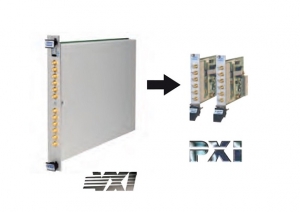
Pickering VXI to PXI Cross Reference
VME eXtensions for Instrumentation (VXI) is an open standard platform for automated test based on the modular VME computer bus. Introduced in 1987, this modular chassis-based architecture reduced the size and increased the performance of high-end test systems. VXI systems provided higher data transfer rates and real-time performance not possible with rack-and stack systems, and were principally successful in the military and aerospace markets. However, VXI is now over 30 years old and many of the leading T&M companies are now no longer supporting the standard.
More test systems designers are choosing the PCI eXtensions for Instrumentation (PXI) platform when designing new modular test systems or replacing or updating existing test systems such as VXI. Originally introduced in 1997, PXI is an open T&M standard now supported by almost 70 companies working under the umbrella of the PXI Systems Alliance (PXISA), which publishes the PXI specification and ensures instrumentation interoperability. Pickering Interfaces is one of six current Board level members of the PXISA.
Features:
- Better Availability of PXI
- Hardware costs are lower for PXI
- PXI throughput at peak bandwidth of 132 MB/s
- PXI modules are significantly smaller in footprint
-
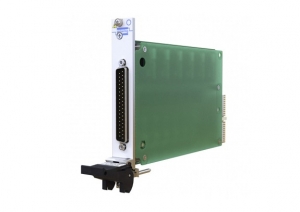
Pickering 41-752A Battery Simulator
The Pickering Model 41-752 new Battery Simulator modules occupy a single PXI slot. These 6-channel Battery Simulators are capable of supplying up to 7 V and 300 mA per channel. The channels are fully isolated from ground and from each other, allowing series connection to simulate batteries in a stacked architecture. The 750 V isolation barrier allows the module to be used as a lower power version of a battery stack, representative of those used for vehicle propulsion.
- Available as PXI or PXIe Modules
- 6, 4 or 2 Battery Cell Simulators In A Single Slot
- Voltage & Current Readback Option
- Independent Sense Connections
- Up To 300 mA Output Per Simulator
- 750 V Independent Isolation Barriers
-
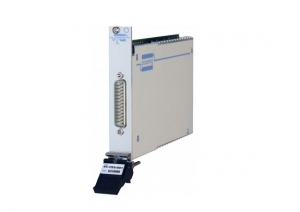
Pickering 41-753 Battery Simulator
The Pickering 41-753 is a Battery Simulator module that can be used to simulate the power supplies of cellular phones and other portable battery devices. It features fully floating output terminals that can deliver voltages up to 6 Volts. The fast responding remote sense connections allow the module to regulate the supply voltage at the device under test. The output terminals can float ±50V relative to the front panel ground to ensure the accurate simulation of battery operation.
- Single Slot Battery Simulator Module
- Output Voltage up to 6V
- Output Current: 2.8A
- Independent Sense Connections
- Programmable Output Resistance
- Programmable Current Sink Capability to 0.5A For Charger Load Simulation
-
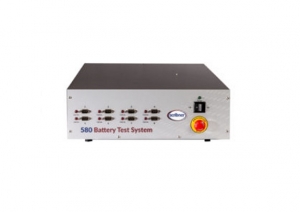
Scribner 580 Battery Tester
The Scribner Model 580 Battery Test System was designed to meet and exceed Battery testing requirements and is used to test both single cell batteries as well as super-capacitors. It has 6 current ranges up to 1 Amp capability.
Our powerful, flexible, user friendly BCycle® software is included with the instrument.
- 6 current ranges – 1 A, 100 mA, 10 mA, 1 mA, 100 ?A, 10 ?A (Auto)
- 5 terminal measurement
- Control modes: current, voltage, power
- HFR for internal resistance
- 100 pts/sec sample rate
- BCycle® and BView® software – user-friendly, powerful, flexible
-
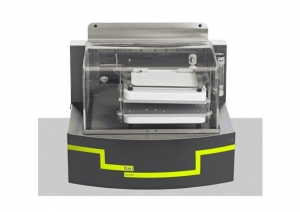
HEL Group ISO Battery Testing Calorimeter
The iso-BTC (Battery Testing Calorimeter) is an isothermal calorimeter designed for the characterization of thermal behavior and electrical performance of battery cells under normal and extended use conditions. It supports a range of adaptors which allows a wide range of cell formats to be analyzed.
The iso-BTC supports the full integration of a Charge-Discharge unit, allowing for the repeated, automated cycling of battery cells under a range of operating conditions, while concurrently recording both the battery’s electrical performance and the heat evolved. It can also conduct accelerated aging tests, allowing the effect of battery aging on cell performance to be investigated. Battery chemistry, electrode composition, and battery cell type can also be investigated within cell development using the iso-BTC.
Thermal mapping (multipoint temperature measurement) allows the user to identify regions of a battery that generate greater thermal energy to be highlighted. Along with the Thermal Behavior characterization of the battery cell over a range of temperatures and Charge/Discharge rates, this information can be used to inform effective and targeted thermal management strategies within the battery module and pack.
Includes:
- Effect of Battery Aging
- Thermal Behavior Characterization
- Thermal Mapping
- Records Electrical & Heat Evolvement
-
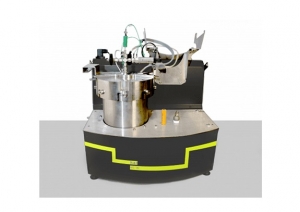
HEL Group BTC150 Battery Testing Calorimeter
The HEL Group BTC-130 Battery Testing Calorimeter is a bench-scale Adiabatic calorimeter designed to enable the testing of Thermal, Electrical, and Mechanical Stress tests on smaller-sized battery cells. Evaluation of these tests facilitates the assessment of the safety performance of battery cells, the battery’s safe operating limits, and research and development into the mechanisms of thermal runaway. The BTC-130 also supports the use of small-volume ARC-type test cells, enabling thermal stability screening of individual battery cell components under adiabatic conditions.
Includes:
- Component Hazard Screening
- Characterizing differences in cell performance
- Defining safe operating limits
- Exploring thermal runaways and thermal propagation
-
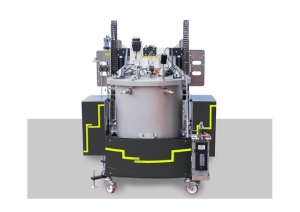
HEL Group BTC500 Battery Testing Calorimeter
The HEL Group BTC-500 Battery Testing Calorimeter) is a floor-standing Adiabatic Calorimeter for the safe testing of Thermal, Electrical, and Mechanical Stress and Abuse) tests on larger battery cells, and small modules. Evaluation of these tests facilitates the assessment of the safety performance of battery cells, enables the battery’s safe operating limits to be defined, and facilitates research and development into the mechanisms of thermal runaway and thermal propagation.
Includes:
- Component Hazard Screening
- Characterizing differences in cell performance
- Defining safe operating limits
- Exploring thermal runaways and thermal propagation
-
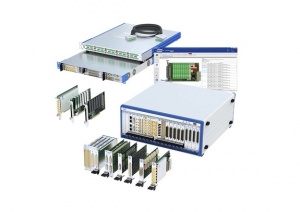
Pickering Switch Products
Enhance your engineering team’s effectiveness by working with our collaborative, creative and agile culture. Our over 50 years of experience in switching for automated test, along with a continually expanding range of PXI, PCI, LXI and USB switching and Simulation products, software and services—can help to streamline the development and deployment of your high-performance electronic test and verification systems
Features:
- PXI, PCI, LXI & USB Switch Systems
- Simulation Modules
- Programmable Resistor Modules
- RF & Microwave Switch Systems
- Optical Switch Systems
- Multiplexer and Matrix Systems
-
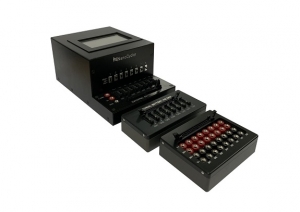
NanoBase NanoCycler Battery Tester
The New NanoBase Nanocycler Battery Tester is a response to researchers in Chemistry, Chemical Engineering and Electrical Engineering as well as commercial testing companies who demanded a more cost-effective Battery Cycler. It is supplied with a comprehensive software solution that has an easy User Interface which includes Channel Control and Monitoring, Sequence Editing, Channel Summarisation and Plotting, making it a Simple, Compact and Expandable Battery Testing solution.
- 8 Channels expandable to 80+ Channels
- Voltage Range: 0 – 5V
- Current Ranges: 200uA, 2mA, 20mA & 200mA
- Measurement Resolution: 16Bits
- Compact form factor and size
- Battery Test Software
-
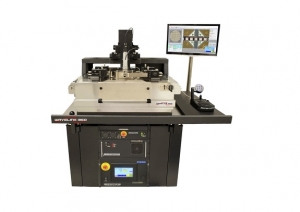
Signatone Wavelink WL350 Probe Station System
The Signatone WaveLink WL-350-LE is a 300mm Semi-Automatic Probe System with a Local Enclosure for Reliable and Accurate RF applications with 2 & 4 port setup, DC, CV/IV, Pulsed –IV Test Measurements. The WL-350-LE is available in multiple and flexible configurations including a variety of Chuck options, DC/RF/High Power Positioners, Computer Aided Probes, Microscopes and Camera’s.
- Travel Range: 300mm
- Programmable X, Y, Z and Theta Chuck Stages
- Temperature Range: -60 °C to +300 °C
- Complete range of MicroPositioners
- Low Current Analysis
- HF & RF Microwave Probing
- Millimeter Wave Probing
- Thermal Characterization
-
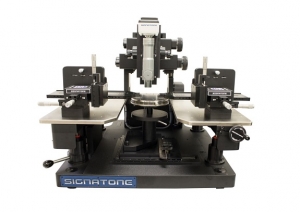
Signatone Wavelink WL170 THz Probe Station System
The Signatone WL-170-THZ 200 mm Manual Probe System is an Industry proven Probe System designed for reliable and accurate test of mmW, THz, and Impedance Tuner applications. The WL-170-THZ is designed for a wide variety of banded, differential or broadband frequency Extenders and Automated Impedance Tuners with seamless integration of Extenders/Tuners provides a maximum of measurement dynamics. It is available in multiple configurations including a variety of chuck options, DC/RF/mmW Micro Positioners, Microscopes, Camera’s, PCB holders, and optional instrumentation racks, Vibration Isolation tables, and Thermal Chuck.
- X, Y Chuck Travel Range: 200mm
- DC To THz Probe Head Selection
- Complete range of MicroPositioners
- Frequency Extenders and Tuner Compatability
- HF & RF Microwave Probing
- Millimeter Wave Probing
- CV/IV Measurements & Failure Analysis
-
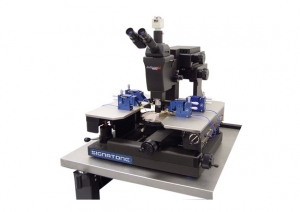
Signatone Checkmate Probe Station System
The Checkmate CM210 has manual control of both wafer and microscope stages and is pre-wired for easy in-the-field upgrade to motorized control. The CM220 has joystick controlled motorized movement of both the microscope and wafer stage. The CM230 has a joystick unit with precision dials to control both the microscope and wafer stages.
The Signatone CheckMate is an ultra-stable 200mm / 300mm analytical probe station with coarse and fine wafer stage movement to provide fast wafer movement as well as submicron resolution. The CheckMate series of analytical probe stations reflects a very simple philosophy of design – make it strong, make it stable, make it accurate and above all, make it easy to use.
- 10″ Cross-Roller Bearings for Smooth, Stable Operation
- Leadscrew driven contact/separate control with hard “Downstop” for Repeatability
- Nickel Steel or Aluminium Platens
- 2″ Platen range with lock
- 4 Point Platen support and lift
- Pneumatic Chuck Contact/Separate switch
-
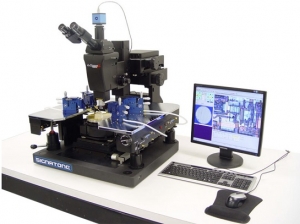
Signatone CM460 SemiAutomatic Probe Station System
The CM460 is a 6″ Semi-Automatic Probe Station, rich in features and capability, that offer a human engineered interface to make operation easy and intuitive. CM460 Systems can be configured for a variety of applications including microwave probing, low current (femtoamp) probing, thermal probing, design/debug, failure analysis, product engineering and many other probing applications.
Systems incorporate a proprietary linear induction motor and an optical feedback positioning system to drive and control the wafer stage. This marriage of sophisticated technologies has given Signatone a leading edge in performance, reliability and accuracy. All systems include automated wafer stepping controlled via the Signatone Solutions Windows software and motorized theta with a quick two-point align feature. Options include programmable motorized microscope movement, auto focus, computer aided probes, on screen video, a unique joystick/thumbwheel control unit, and many other powerful features.
- 150mm Linear Motor Drive
- 2 Point Software Alignment
- Software Z Control
- 2″ and 6″ Manual/ Programmable/Hybrid Microscope
- Optional 4″ Microscope lift
-

Active Technologies ArbRider 5000 Arbitrary Waveform Generator
Active Technologies ARB Rider AWG-5000 is the world’s fastest 16 bit Arbitrary Waveform Generator: 6.16 Gs/s update rate and 16 bit vertical resolution. Available in 2, 4 or 8 channel models, Arb Rider AWG-5000 is the fastest AFG (Arbitrary Function Generator) in the world, reaching up to 2 GHz sine wave. Thanks to Simple Rider software, AWG-5000 offers best in class performances and extremely easy to use interface.
2 GHz bandwidth, up to 5Vpp output range and up to 4 Gsample memory depth, makes the AWG-5000 is the ideal choice for Physics Experiments, Quantum computers, and Aerospace & Defense applications.
- 2, 4, 8 Channels
- 2GHz Bandwidth
- 6.16 GS/s Sampling Rate
- 16Bit Resolution
- 5Vpp Output
- 2-4Gpts Waveform Memory
- 8-32 Digital Channels (Pattern Generator)
-
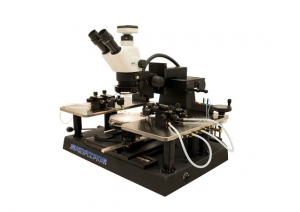
Signatone S1160 Probe Station System
The Signatone S-1160 probe station is used universally to achieve precise measurement results incorporating proven technology for I-V/C-V measurements. The S-1160 is equipped with ergonomically positioned controls and is available with a significant variety of options giving users greater application flexibility.
The S-1160 optimizes user test time and accommodates both stereozoom and high magnification microscopes and CCD camera mounting. At Signatone we know that X-Y-Z accuracy is the name of the game, whether you are moving the microscope stage or the DUT stage, the S-1160’s smooth X-Y-Z motion control is unrivaled. The singular, steel platen provides a stable platform for up to 12 Signatone micropositioners. The platen quick lift handle is ergonomically placed for quick up-down motion of the platen moving your probe tips out of contact on your DUT; this allows for quick X-Y positioning of the DUT stage and DUT loading and unloading. The platen fine adjustment knob gives users 5 micron resolution for fine Z adjustments for all of their probes simultaneously and allows users the height adjustments that they need for a variety of device sizes and shapes up to 1.35 inches in thickness.
- Triocular Stereo Zoom or High Magnification Microscope
- Supports DC, Coax, Triax Probe connection
- Large Steel Platen
- Linear Platen lift Lever
- Chuck Rotation Lever
- Vacuum Chuck
- Vibration Damping
-
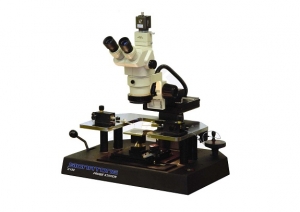
Signatone H150 Probe Station System
The Signatone H-100 Series Probe Stations include a three inch square device / substrate chuck and are primarily designed for probing thick film devices such as ceramic substrates, printed circuit boards and hybrid circuits. The H-150 system, however, can be equipped with a four inch diameter wafer chuck for probing wafers up to four inches in diameter. H-100 Series Probe Stations are available in three versions: H-100, H-120 and H-150.
The modular design provides a wide number of options to suit a broad range of needs. All models include an aluminum base casting, a device stage with four inches of X-Y travel, a linear motion platen that can be raised and lowered using either a crank or a lever, and a microscope tower for mounting Stereozoom optics in a fixed position. A 4″ x 4″ microscope stage is optional. The platen will accept up to six magnetic based Micropositioners and a probe card adapter for use with probe cards. Micropositioner electrical connections are made through six pin jacks that correspond to color coded banana plugs.
- 4″ x 4″ Stage Movement
- Positioning Samples up tp 4″ Square
- Fine Platen lift allows accurate set-up Positioning of Wafers, Ceramic Substrates or Deep Cavity Packages
- Coarse Platen lift lever raises the platen 3/8″ for easy sample repositioning or changing
